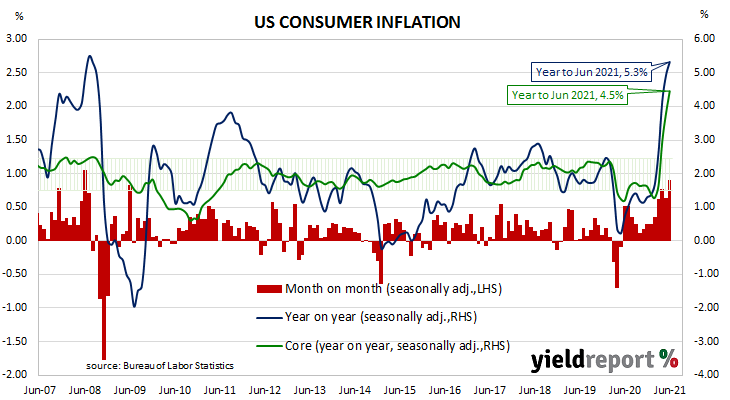Summary: US CPI jumps by 0.9% in June; nearly double expectations; “core” rate up 0.9%, double expected figure; “mostly transitory” given used-car contribution; rises in categories tied to reopening and temporary supply shortages may give Fed “more confidence” higher inflation rate temporary.
The annual rate of US inflation as measured by changes in the consumer price index (CPI) halved from nearly 3% in the period from July 2018 to February 2019. It then fluctuated in a range from 1.5% to 2.0% through 2019 before rising above 2.0% in the final months of that year. Substantially lower rates were reported from March 2020 to May 2020 and they remained below 2% until March of this year.
The latest CPI figures released by the Bureau of Labor Statistics indicated seasonally-adjusted consumer prices jumped by 0.9% on average in June. The result was nearly double the 0.5% increase which had been generally expected and greater than May’s 0.6% rise. On a 12-month basis, the inflation rate accelerated from May’s seasonally adjusted reading of 4.9% to 5.3%.
“Headline” inflation is known to be volatile and so references are often made to “core” inflation for analytical purposes. Core inflation, a measure of inflation which strips out the volatile food and energy components of the index, also jumped by 0.9% on a seasonally-adjusted basis for the month. The result was more than double the expected figure of 0.4% and more than May’s 0.7% increase. The annual rate accelerated again, this time from 3.8% to 4.5%.
“The key question for the Fed and markets in general is whether the sustained lift in inflation seen over the past couple of months is still likely to be transitory, or will it be more persistent, warranting an earlier normalisation in Fed policy,” said NAB senior economist Tapas Strickland. In his view, “the rise is mostly transitory” given used-car prices contributed over 0.4% to the increase of the core measure.
US Treasury bond yields rose on the day. By the close of business, the 2-year yield had added 3bps to 0.26%, the 10-year yield had gained 6bps to 1.42% while the 30-year yield finished 5bps higher at 2.05%.
In terms of US Fed policy, expectations of any change in the federal funds range over the next 12 months remained fairly soft. July 2022 futures contracts implied an effective federal funds rate of 0.17%, 7bps above the spot rate.


